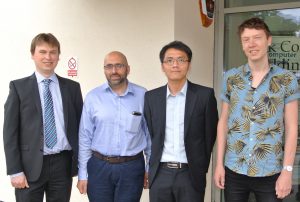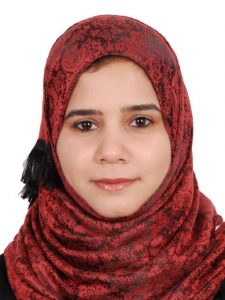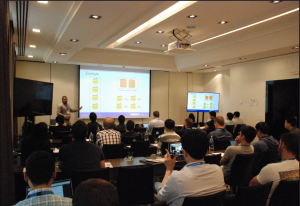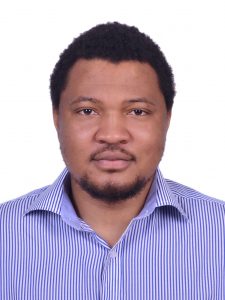Congratulations to Long Thai, who successfully defended his thesis today. He is pictured with supervisor Dr Adam Barker, Internal examiner Dr John Thomson and external examiner Dr Rami Bahsoon, from the University of Birmingham. Long is joining Amazon as a Software Engineer.

Research Groups
Seminar: Propagation and Reification: SAT and SMT in Prolog (continued)
Jacob Howe, City University, London
Event details
- When: 23rd June 2017 13:00 - 14:00
- Where: Cole 1.33a
- Series: AI Seminar Series
- Format: Seminar
SRG Seminar: Evaluation Techniques for Detection Model Performance in Anomaly Network Intrusion Detection System by Amjad Al Tobi
Everyday advancements in technology brings with it novel challenges and threats. Such advancement imposes greater risks than ever on systems and services, including individual privacy information. Relying on intrusion specialists to come up with new signatures to detect different types of new attacks, does not seem to scale with excessive traffic growth. Therefore, anomaly-based detection provides a promising solution for this problem area.

Anomaly-based IDS applies machine learning, data mining and/or artificial intelligence along with many other methods to solve this problem. Currently, these solutions seem not to be tractable for real production environments due to the high false alarms rate. This might be a result of such systems not being able to determine the point at which an update is required. It is not clear how detection models will behave over time, when traffic behaviour has changed since the last time the model was re-generated.
Continue reading
Event details
- When: 1st June 2017 13:00 - 14:00
- Where: Cole 1.33b
- Series: Systems Seminars Series
- Format: Seminar
SRG Seminar: New Network Functionality using ILNPv6 and DNS by Khawar Shehzad
This research deals with the introduction of a new network functionality based on Identifier-Locator Network Protocol version 6 (ILNPv6), and Domain Name System (DNS). The chosen area of concern is security and specifically mitigation of Distributed Denial of Service (DDoS). The functionality proposed and tested deals with the issues of vulnerability testing, probing, and scanning which directly lead to a successful DDoS attack. The solutions presented can be used as a reactive measure to these security issues. The DDoS is chosen because in recent years DDoS have become the most common and hard to defend attacks. These attacks are on the availability of system/site. There are multiple solutions in the literature but no one solution is based on ILNPv6, and are complex in nature. Similarly, the solutions in literature either require modification in the providers’ networks or they are complex if they are only site-based solutions. Most of these solutions are based on IPv6 protocol and they do not use the concept of naming, as proposed by ILNPv6.
The prime objectives of this research are:
- to defend against DDoS attacks with the use of naming and DNS
- to increase the attacker’s effort, reduce vulnerability testing, and random probing by attackers
- to practically demonstrate the effectiveness of the ILNPv6-based solution for security
Event details
- When: 18th May 2017 13:00 - 14:00
- Where: Cole 1.33b
- Series: Systems Seminars Series
- Format: Seminar
Prizes for Haifa Al Nasseri
At the Cyber Academy’s International Conference on Big Data in Cyber Security on May 10 2017 at Edinburgh Napier’s Craiglockhart Campus, PhD student Haifa Al Nasseri won two 3rd prizes. One was for her research poster on Cloud Virtual Network Isolation Security and the other was for her team’s efforts in the Splunk Hackathon.
SRG Seminar: Investigation of Virtual Network Isolation Security in Cloud Computing Using Penetration Testing by Haifa Al Nasseri
Software Defined Networking (SDN) or Virtual Networks (VNs) are required for cloud tenants to leverage demands. However, multi-tenancy can be compromised without proper isolation. Much research has been conducted into VN Isolation; many researchers are not tackling security aspects or checking if their isolation evaluation is complete. Therefore, data leakage is a major security concern in the cloud in general.

This research uses an OpenStack VN and OpenStack Tenant Network to test multi-tenancy features. We are evaluating the relationship between isolation methods used in cloud VN and the amount of data being leaked through using penetration tests. These tests will be used to identify the vulnerabilities causing cloud VN data leakage and to investigate how the vulnerabilities, and the leaked data, can compromise the tenant Virtual Networks.
Event details
- When: 4th May 2017 13:00 - 14:00
- Where: Cole 1.33b
- Series: Systems Seminars Series
- Format: Talk
Workshop on Considering Technology through a Philosophical Lens
 Technology fundamentally shapes our communication, relationships, and access to information. It also evolves through our interaction with it. Dialoguing across disciplines can facilitate an understanding of these complex and reciprocal relationships and fuel reflection and innovation.
Technology fundamentally shapes our communication, relationships, and access to information. It also evolves through our interaction with it. Dialoguing across disciplines can facilitate an understanding of these complex and reciprocal relationships and fuel reflection and innovation.
This hands-on, participant-driven and experimental workshop will start a discussion of what can come from considering technology through a philosophical lens. Through discussions and hands-on design activities, it will provide an introduction to and reflection on questions at the intersection of computer science and philosophy, such as:
- How have philosophy and technology shaped each other in the past?
- How can philosophical ideas and methods guide research in Computer Science?
- How can thinking through technology help Humanities researchers discover relevance and articulate impact in their research?
Engaging these questions can provide participants an entry-point into exploring these themes in the context of their own research.
This workshop is aimed at researchers from computer science who are curious about philosophy and how to leverage it to inform technically oriented research questions and designing for innovation. It is also aimed at researchers in the arts & humanities, social sciences, and philosophy who are curious about current research questions and approaches in computer science and how questions of technology can stimulate philosophical thought and research.
Attending the workshop is free but please register by emailing Nick Daly: nd40[at]st-andrews.ac.uk
Organisers: Nick Daly (School of Modern Languages) and Uta Hinrichs (School of Computer Science)
Event details
- When: 18th May 2017 10:00 - 13:00
- Where: Cole 1.33a
- Format: Workshop
SRG at IEEE CCGrid 2017
Congratulations to Uchechukwu Awada, who presented “Improving resource efficiency of container-instance clusters on clouds” at the 17th IEEE/ACM International Symposium on Cluster, Cloud and Grid Computing.

SRG Seminar: “Evaluating Data Linkage: Creation and use of synthetic data for comprehensive linkage evaluation” by Tom Dalton and “Container orchestration” by Uchechukwu Awada
The abstract of Tom’s talk:
“Data linkage approaches are often evaluated with small or few data sets. If a linkage approach is to be used widely, quantifying its performance with varying data sets would be beneficial. In addition, given a data set needs to be linked, the true links are by definition unknown. The success of a linkage approach is thus difficult to comprehensively evaluate.
This talk focuses on the use of many synthetic data sets for the evaluation of linkage quality achieved by automatic linkage algorithms in the domain of population reconstruction. It presents an evaluation approach which considers linkage quality when characteristics of the population are varied. We envisage a sequence of experiments where a set of populations are generated to consider how linkage quality varies across different populations: with the same characteristics, with differing characteristics, and with differing types and levels of corruption. The performance of an approach at scale is also considered.
The approach to generate synthetic populations with varying characteristics on demand will also be addressed. The use of synthetic populations has the advantage that all the true links are known, thus allowing evaluation as if with real-world ‘gold-standard’ linked data sets.
Given the large number of data sets evaluated against we also give consideration as to how to present these findings. The ability to assess variations in linkage quality across many data sets will assist in the development of new linkage approaches and identifying areas where existing linkage approaches may be more widely applied.”
The abstract of Awada’s talk:
“Over the years, there has been rapid development in the area of software development. A recent innovation in software or application deployment and execution is the use of Containers. Containers provide a lightweight, isolated and well-defined execution environment. Application container like Docker, wrap up a piece of software in a complete file-system that contain everything it needs to run: code, runtime, system tools, system libraries, etc. To support and simplify large-scale deployment, cloud computing providers (i.e., AWS, Google, Microsoft, etc) have recently introduced Container Service Platforms (CSPs), which support automated and flexible orchestration of containerised applications on container-instances (virtual machines).

Existing CSP frameworks do not offer any form of intelligent resource scheduling: applications are usually scheduled individually, rather than taking a holistic view of all registered applications and available resources in the cloud. This can result in increased execution times for applications, and resource wastage through under utilised container-instances; but also a reduction in the number of applications that can be deployed, given the available resources. In addition, current CSP frameworks do not currently support: the deployment and scaling of containers across multiple regions at the same time; merging containers into a multi-container unit in order to achieve higher cluster utilisation and reduced execution times.
Our research aims to extend the existing system by adding a cloud-based Container Management Service (CMS) framework that offers increased deployment density, scalability and resource efficiency. CMS provides additional functionalities for orchestrating containerised applications by joint optimisation of sets of containerised applications and resource pool in multiple (geographical distributed) cloud regions. We evaluate CMS on a cloud-based CSPs i.e., Amazon EC2 Container Management Service (ECS) and conducted extensive experiments using sets of CPU and Memory intensive containerised applications against the custom deployment strategy of Amazon ECS. The results show that CMS achieves up to 25% higher cluster utilisation and up to 70% reduction in execution times.”
Event details
- When: 20th April 2017 13:00 - 14:00
- Where: Cole 1.33b
- Series: Systems Seminars Series
- Format: Seminar
ACM SIGCHI: Communication Ambassador & Turing Award Celebration News
Congratulations to Hui-Shyong Yeo, who has been selected as both an ACM SIGCHI communication ambassador and to represent SIGCHI at the ACM 50 Years of the A.M. Turing Award Celebration.
 Yeo is a 2nd year PhD student and is particularly interested in exploring and developing novel interaction techniques. Since joining us in SACHI, he has had work accepted at ACM CHI 2016 and CHI 2017, ACM MobileHCI 2016 and 2017 and ACM UIST 2016. His work has featured at Google I/O 2016, locally on STV news and he gave a talk at Google UK in 2016 about his research. His work has also featured in the media including in Gizmodo, TheVerge, Engadget and TechCrunch., see his personal website for more details. Continue reading
Yeo is a 2nd year PhD student and is particularly interested in exploring and developing novel interaction techniques. Since joining us in SACHI, he has had work accepted at ACM CHI 2016 and CHI 2017, ACM MobileHCI 2016 and 2017 and ACM UIST 2016. His work has featured at Google I/O 2016, locally on STV news and he gave a talk at Google UK in 2016 about his research. His work has also featured in the media including in Gizmodo, TheVerge, Engadget and TechCrunch., see his personal website for more details. Continue reading

